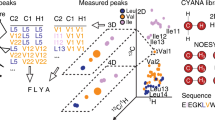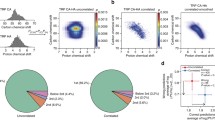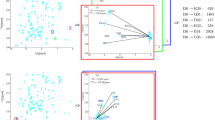Abstract
Direct methods in NMR based structure determination start from an unassigned ensemble of unconnected gaseous hydrogen atoms. Under favorable conditions they can produce low resolution structures of proteins. Usually a prohibitively large number of NOEs is required, to solve a protein structure ab-initio, but even with a much smaller set of distance restraints low resolution models can be obtained which resemble a protein fold. One problem is that at such low resolution and in the absence of a force field it is impossible to distinguish the correct protein fold from its mirror image. In a hybrid approach these ambiguous models have the potential to aid in the process of sequential backbone chemical shift assignment when 13Cβ and 13C′ shifts are not available for sensitivity reasons. Regardless of the overall fold they enhance the information content of the NOE spectra. These, combined with residue specific labeling and minimal triple-resonance data using 13Cα connectivity can provide almost complete sequential assignment. Strategies for residue type specific labeling with customized isotope labeling patterns are of great advantage in this context. Furthermore, this approach is to some extent error-tolerant with respect to data incompleteness, limited precision of the peak picking, and structural errors caused by misassignment of NOEs.






Similar content being viewed by others
References
Bermejo GA, Llinas M (2008) Deuterated protein folds obtained directly from unassigned nuclear overhauser effect data. J Am Chem Soc 130:3797–3805
Bowers PM, Strauss CE, Baker D (2000) De novo protein structure determination using sparse NMR data. J Biomol NMR 18:311–318
Brünger AT (1993) X-PLOR (Version 3.1) a system for X-ray crystallography and NMR. Yale University Press, New Haven
Brunger AT, Adams PD, Clore GM, DeLano WL, Gros P, Grosse-Kunstleve RW, Jiang JS, Kuszewski J, Nilges M, Pannu NS, Read RJ, Rice LM, Simonson T, Warren GL (1998) Crystallography & NMR system: a new software suite for macromolecular structure determination. Acta Crystallogr D Biol Crystallogr 54:905–921
Cavanagh J, Fairbrother AG, Palmer AG, Skelton NJ (1996) Protein NMR Spectroscopy. Academic Press, New York
Clore GM, Nilges M, Sukumaran DK, Brunger AT, Karplus M, Gronenborn AM (1986) The three-dimensional structure of alpha1-purothionin in solution: combined use of nuclear magnetic resonance, distance geometry and restrained molecular dynamics. EMBO J 5:2729–2735
Clore GM, Nilges M, Brunger AT, Karplus M, Gronenborn AM (1987a) A comparison of the restrained molecular dynamics and distance geometry methods for determining three-dimensional structures of proteins on the basis of interproton distances. FEBS Lett 213:269–277
Clore GM, Sukumaran DK, Nilges M, Zarbock J, Gronenborn AM (1987b) The conformations of hirudin in solution: a study using nuclear magnetic resonance, distance geometry and restrained molecular dynamics. EMBO J 6:529–537
Clubb RT, Thanabal V, Wagner G (1992) A constant-time 3-dimensional triple-resonance pulse scheme to correlate intraresidue H-1(N), N-15, and C-13(‘) chemical-shifts in N-15-C-13-labeled proteins. J Magn Reson 97:213–217
Creighton TE (1992) Proteins: structures and molecular properties. Freeman, W. H, San Francisco, USA
Evans JNS (1995) Biomolecular NMR spectroscopy. Oxford University Press, New York
Farrow NA, Muhandiram R, Singer AU, Pascal SM, Kay CM, Gish G, Shoelson SE, Pawson T, Forman-Kay JD, Kay LE (1994) Backbone dynamics of a free and phosphopeptide-complexed Src homology 2 domain studied by 15N NMR relaxation. Biochemistry 33:5984–6003
Furst J, Schedlbauer A, Gandini R, Garavaglia ML, Saino S, Gschwentner M, Sarg B, Lindner H, Jakab M, Ritter M, Bazzini C, Botta G, Meyer G, Kontaxis G, Tilly BC, Konrat R, Paulmichl M (2005) ICln159 folds into a pleckstrin homology domain-like structure. Interaction with kinases and the splicing factor LSm4. J Biol Chem 280:31276–31282
Gardner KH, Kay LE (1998) The use of 2H, 13C, 15N multidimensional NMR to study the structure and dynamics of proteins. Annu Rev Biophys Biomol Struct 27:357–406
Gardner KH, Rosen MK, Kay LE (1997) Global folds of highly deuterated, methyl-protonated proteins by multidimensional NMR. Biochemistry 36:1389–1401
Goto NK, Gardner KH, Mueller GA, Willis RC, Kay LE (1999) A robust and cost-effective method for the production of Val, Leu, Ile (delta 1) methyl-protonated 15N-, 13C-, 2H-labeled proteins. J Biomol NMR 13:369–374
Grishaev A, Llinas M (2002a) CLOUDS, a protocol for deriving a molecular proton density via NMR. Proc Natl Acad Sci USA 99:6707–6712
Grishaev A, Llinas M (2002b) Protein structure elucidation from NMR proton densities. Proc Natl Acad Sci USA 99:6713–6718
Grishaev A, Llinas M (2002c) Sorting signals from protein NMR spectra: SPI, a Bayesian protocol for uncovering spin systems. J Biomol NMR 24:203–213
Grishaev A, Llinas M (2004) BACUS: a Bayesian protocol for the identification of protein NOESY spectra via unassigned spin systems. J Biomol NMR 28:1–10
Grishaev A, Llinas M (2005) Protein structure elucidation from minimal NMR data: the CLOUDS approach. Methods Enzymol 394:261–295
Grishaev A, Steren CA, Wu B, Pineda-Lucena A, Arrowsmith C, Llinas M (2005) ABACUS, a direct method for protein NMR structure computation via assembly of fragments. Proteins 61:36–43
Grzesiek S, Bax A (1992) Correlating backbone amide and side-chain resonances in larger proteins by multiple relayed triple resonance Nmr. J Am Chem Soc 114:6291–6293
Grzesiek S, Bax A (1993) Amino acid type determination in the sequential assignment procedure of uniformly 13C/15N-enriched proteins. J Biomol NMR 3:185–204
Havel TF, Crippen GM, Kuntz ID, Blaney JM (1983a) The combinatorial distance geometry method for the calculation of molecular conformation. II. Sample problems and computational statistics. J Theor Biol 104:383–400
Havel TF, Kuntz ID, Crippen GM (1983b) The combinatorial distance geometry method for the calculation of molecular conformation. I. A new approach to an old problem. J Theor Biol 104:359–381
Hitchens TK, Lukin JA, Zhan Y, McCallum SA, Rule GS (2003) MONTE: an automated Monte Carlo based approach to nuclear magnetic resonance assignment of proteins. J Biomol NMR 25:1–9
Hoffmann B, Eichmuller C, Steinhauser O, Konrat R (2005) Rapid assessment of protein structural stability and fold validation via NMR. Methods Enzymol 394:142–175
Jung YS, Zweckstetter M (2004) Mars–robust automatic backbone assignment of proteins. J Biomol NMR 30:11–23
Kay LE, Gardner KH (1997) Solution NMR spectroscopy beyond 25 kDa. Curr Opin Struct Biol 7:722–731
Kay LE, Ikura M, Tschudin R, Bax A (1990) 3-dimensional triple-resonance Nmr-spectroscopy of isotopically enriched proteins. J Magn Reson 89:496–514
Kontaxis G, Konrat R, Krautler B, Weiskirchen R, Bister K (1998) Structure and intramodular dynamics of the amino-terminal LIM domain from quail cysteine- and glycine-rich protein CRP2. Biochemistry 37:7127–7134
Koradi R, Billeter M, Wuthrich K (1996) MOLMOL: a program for display and analysis of macromolecular structures. J Mol Graph 14(51–55):29–32
Korzhnev DM, Kloiber K, Kanelis V, Tugarinov V, Kay LE (2004) Probing slow dynamics in high molecular weight proteins by methyl-TROSY NMR spectroscopy: application to a 723-residue enzyme. J Am Chem Soc 126:3964–3973
Kraulis PJ (1994) Protein three-dimensional structure determination and sequence-specific assignment of 13C and 15N-separated NOE data. A novel real-space ab initio approach. J Mol Biol 243:696–718
Leutner M, Gschwind RM, Liermann J, Schwarz C, Gemmecker G, Kessler H (1998) Automated backbone assignment of labeled proteins using the threshold accepting algorithm. J Biomol NMR 11:31–43
Lichtenecker R, Ludwiczek ML, Schmid W, Konrat R (2004) Simplification of protein NOESY spectra using bioorganic precursor synthesis and NMR spectral editing. J Am Chem Soc 126:5348–5349
Moseley HN, Sahota G, Montelione GT (2004) Assignment validation software suite for the evaluation and presentation of protein resonance assignment data. J Biomol NMR 28:341–355
Nilges M, Macias MJ, O’Donoghue SI, Oschkinat H (1997) Automated NOESY interpretation with ambiguous distance restraints: the refined NMR solution structure of the pleckstrin homology domain from beta-spectrin. J Mol Biol 269:408–422
Pascal SM, Singer AU, Gish G, Yamazaki T, Shoelson SE, Pawson T, Kay LE, Forman-Kay JD (1994) Nuclear magnetic resonance structure of an SH2 domain of phospholipase C-gamma 1 complexed with a high affinity binding peptide. Cell 77:461–472
Pervushin K, Riek R, Wider G, Wuthrich K (1997) Attenuated T2 relaxation by mutual cancellation of dipole-dipole coupling and chemical shift anisotropy indicates an avenue to NMR structures of very large biological macromolecules in solution. Proc Natl Acad Sci USA 94:12366–12371
Pervushin K, Riek R, Wider G, Wuthrich K (1998) Transverse relaxation-optimized spectroscopy (TROSY) for NMR studies of aromatic spin systems in C-13-labeled proteins. J Am Chem Soc 120:6394–6400
Rosen MK, Gardner KH, Willis RC, Parris WE, Pawson T, Kay LE (1996) Selective methyl group protonation of perdeuterated proteins. J Mol Biol 263:627–636
Schedlbauer A, Hoffmann B, Kontaxis G, Rudisser S, Hommel U, Konrat R (2007) Automated backbone and side-chain assignment of mitochondrial matrix cyclophilin D. J Biomol NMR 38:267
Schwieters CD, Clore GM (2001) The VMD-XPLOR visualization package for NMR structure refinement. J Magn Reson 149:239–244
Schwieters CD, Kuszewski JJ, Tjandra N, Clore GM (2003) The Xplor-NIH NMR molecular structure determination package. J Magn Reson 160:65–73
Simons KT, Kooperberg C, Huang E, Baker D (1997) Assembly of protein tertiary structures from fragments with similar local sequences using simulated annealing and Bayesian scoring functions. J Mol Biol 268:209–225
Tugarinov V, Kay LE (2004) An isotope labeling strategy for methyl TROSY spectroscopy. J Biomol NMR 28:165–172
Tugarinov V, Sprangers R, Kay LE (2004) Line narrowing in methyl-TROSY using zero-quantum 1H-13C NMR spectroscopy. J Am Chem Soc 126:4921–4925
Tugarinov V, Kay LE, Ibraghimov I, Orekhov VY (2005) High-resolution four-dimensional 1H-13C NOE spectroscopy using methyl-TROSY, sparse data acquisition, and multidimensional decomposition. J Am Chem Soc 127:2767–2775
Wang J, Wang T, Zuiderweg ER, Crippen GM (2005) CASA: an efficient automated assignment of protein mainchain NMR data using an ordered tree search algorithm. J Biomol NMR 33:261–279
Wittekind M, Mueller L (1993) Hncacb, a high-sensitivity 3d Nmr experiment to correlate amide-proton and nitrogen resonances with the alpha-carbon and beta-carbon resonances in proteins. J Magn Reson B 101:201–205
Zimmerman DE, Kulikowski CA, Huang Y, Feng W, Tashiro M, Shimotakahara S, Chien C, Powers R, Montelione GT (1997) Automated analysis of protein NMR assignments using methods from artificial intelligence. J Mol Biol 269:592–610
Author information
Authors and Affiliations
Corresponding author
Electronic supplementary material
Below is the link to the electronic supplementary material.
Rights and permissions
About this article
Cite this article
Schedlbauer, A., Auer, R., Ledolter, K. et al. Direct methods and residue type specific isotope labeling in NMR structure determination and model-driven sequential assignment. J Biomol NMR 42, 111–127 (2008). https://doi.org/10.1007/s10858-008-9268-9
Received:
Revised:
Accepted:
Published:
Issue Date:
DOI: https://doi.org/10.1007/s10858-008-9268-9




